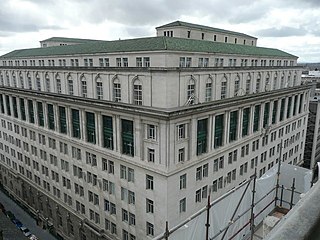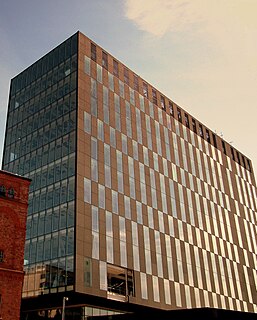
The Queensway tunnel is a road tunnel under the River Mersey, in the north west of England, between Liverpool and Birkenhead. Locally, it is often referred to as the "Birkenhead tunnel" or "old tunnel", to distinguish it from the newer Kingsway tunnel (1971), which serves Wallasey and the M53 motorway traffic. At 3.24 kilometres (2.01 mi) in length, it is the longest road tunnel in the UK.

The Pier Head is a riverside location in the city centre of Liverpool, England. It was part of the former Liverpool Maritime Mercantile City UNESCO World Heritage Site, which was inscribed in 2004, but revoked in 2021. As well as a collection of landmark buildings, recreational open space, and a number of memorials, the Pier Head was the landing site for passenger ships travelling to and from the city.

The Port of Liverpool Building is a Grade II* listed building in Liverpool, England. It is located at the Pier Head and, along with the neighbouring Royal Liver Building and Cunard Building, is one of Liverpool's Three Graces, which line the city's waterfront. It is also part of Liverpool's formerly UNESCO-designated World Heritage Maritime Mercantile City.

St George's Hall is a building on St George's Place, opposite Lime Street railway station in the centre of Liverpool, England. Opened in 1854, it is a Neoclassical building which contains concert halls and law courts, and is recorded in the National Heritage List for England as a designated Grade I listed building. On the east side of the hall, between it and the railway station, is St George's Plateau and on the west side are St John's Gardens. The hall is included in the William Brown Street conservation area.

Wapping or Edge Hill Tunnel in Liverpool, England, is a tunnel route from the Edge Hill junction in the east of the city to the Liverpool south end docks formerly used by trains on the Liverpool-Manchester line railway. The tunnel alignment is roughly east to west. The tunnel was designed by George Stephenson with construction between 1826 and 1829 to enable goods services to operate between Liverpool docks and all locations up to Manchester, as part of the Liverpool and Manchester Railway. It was the first transport tunnel in the world to be bored under a city. The tunnel is 2,030 metres (1.26 mi) long, running downhill from the western end of the 262 metres (860 ft) long Cavendish cutting at Edge Hill in the east of the city, to Park Lane Goods Station near Wapping Dock in the west. The Edge Hill portal is near the former Crown Street Station goods yard. The tunnel passes beneath the Merseyrail Northern Line tunnel approximately a quarter of a mile south of Liverpool Central underground station.
Merseytravel is the passenger transport executive, responsible for the coordination of public transport in the Liverpool City Region in North West England. Merseytravel was established on 1 December 1969 as the Merseyside Passenger Transport Executive. From 1 April 2014, with the creation of the Liverpool City Region, Merseytravel expanded its area of operation from the metropolitan county of Merseyside to also include the Borough of Halton.

India Buildings is a commercial building with its principal entrance in Water Street, Liverpool, Merseyside, England. Mainly an office building, it also contained an internal shopping arcade and the entrance to an underground station. It was built between 1924 and 1932, damaged by a bomb in 1941, and later restored to its original condition under the supervision of one of its original architects. The building, its design influenced by the Italian Renaissance and incorporating features of the American Beaux-Arts style, occupies an entire block in the city.

Herbert James Rowse was an English architect. Born in Liverpool and a student of Charles Reilly at the Liverpool University School of Architecture, Rowse opened an architectural practice in the city. Although he designed major buildings for other cities, Rowse is best known for his work in Liverpool, including India Buildings, the entrances to and ventilation towers of the Mersey Tunnel ("Queensway"), and the Philharmonic Hall. He designed in a range of styles, from neoclassical to Art Deco, generally with a strong American influence.

The Wirral line is one of two commuter rail routes operated by Merseyrail and centred on Merseyside, England, the other being the Northern line.

Woodside is a small riverside locality in Birkenhead, on the Wirral Peninsula, England, situated almost opposite Liverpool Pier Head across the River Mersey.

The Victoria Tunnel in Liverpool, England is a 1.537 miles (2.474 km) long rail tunnel. Opened in 1849, its eastern portal is adjacent to Edge Hill station. The western portal opens into a short cutting, between Byrom Street and Fontenoy Street, the shorter Waterloo Tunnel exits the cutting terminating at Waterloo Dock. The Victoria and Waterloo tunnels are effectively one long tunnel connected by a ventilation cutting. The whole length is generally known as the Waterloo Tunnel.
Charles John Allen was a British sculptor, and a figure in the New Sculpture movement.

The architecture of Liverpool is rooted in the city's development into a major port of the British Empire. It encompasses a variety of architectural styles of the past 300 years, while next to nothing remains of its medieval structures which would have dated back as far as the 13th century. Erected 1716–18, Bluecoat Chambers is supposed to be the oldest surviving building in central Liverpool.
Liverpool in North West England, is a major British city with significant road, rail, and ferry networks, in addition to an international airport and a well-known dock system. As with most other major UK cities, Liverpool's transport infrastructure is centred on its road and rail networks. Public transport services within the city are controlled and run by Merseytravel.

The Mann Island Buildings are a group of buildings in Liverpool, England. They comprise three international style mixed use buildings on Mann Island, which lies on the waterfront between the Port of Liverpool Building and the Albert Dock. No.1 building is owned by Merseytravel although several floors are leased out to other companies

Liverpool city centre is the commercial, cultural, financial and historical centre of Liverpool, England.
The Liverpool Marathon was a road race held in Liverpool, England and its neighbouring borough Wirral founded 2011. It was seen as the successor to the Mersey Marathon which last took place in 1992.

Edmund Charles Thompson MBE was an English sculptor, active in Liverpool between the First and Second World War. The son of sculptor Edmund T. Thompson, he worked in the art deco style and was an admirer of Eric Gill.

The Monument to the Mersey Tunnel stands in Chester Street, Birkenhead, Wirral, Merseyside, England, near the western entrance to the Queensway Tunnel, one of the two Mersey Tunnels carrying roads under the River Mersey between Liverpool and the Wirral. It consists of shaft with a light on the top, and originally had the dual purpose of being a monument and of illuminating the entrance to the tunnel. It was designed by Herbert James Rowse, and was one of a pair, but the monument that was on the Liverpool side of the River Mersey no longer exists. The monument is recorded in the National Heritage List for England as a designated Grade II listed building.
















